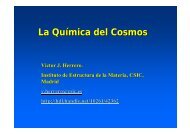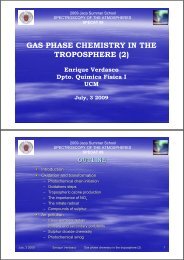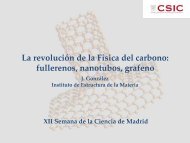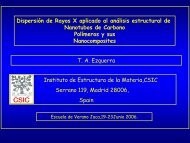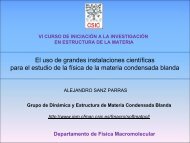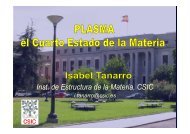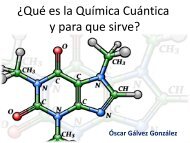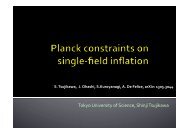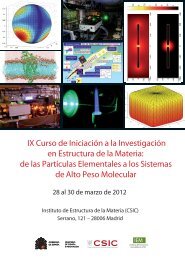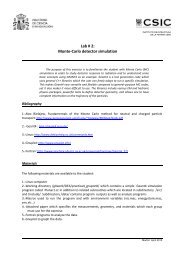ANNUAL REPORT 2011 - Instituto de Estructura de la Materia
ANNUAL REPORT 2011 - Instituto de Estructura de la Materia
ANNUAL REPORT 2011 - Instituto de Estructura de la Materia
Create successful ePaper yourself
Turn your PDF publications into a flip-book with our unique Google optimized e-Paper software.
spectroscopy and mass spectrometry. By means of a recently acquired cryostat we can extend our experimentalrange down to 6 K covering a temperature interval very interesting in astrophysics. In the following paragraphs we<strong>de</strong>scribe in more <strong>de</strong>tail the main contributions achieved during the <strong>la</strong>st year.We have initiated a line of research with some astrobiological propensity. The molecule of glycine has been <strong>de</strong>tectedon cometary grains, and a comprehensive spectroscopic investigation of this species in different environments andphysical conditions was not yet avai<strong>la</strong>ble. We therefore performed a spectroscopic study of glycine in its neutral andionic structures, iso<strong>la</strong>ted and in po<strong>la</strong>r and non-po<strong>la</strong>r environments, and followed changes in its structure for a rangeof temperatures between 25 and 200 K. To sublimate solids with low vapour pressure, like the aminoacid glicine, wehave <strong>de</strong>signed and built a mini-oven that allows vo<strong>la</strong>tilizing the sample un<strong>de</strong>r vacuum and <strong>de</strong>positing its vapor on acold substrate. We have also improved the experiment adding a system to rotate the substrate un<strong>de</strong>r vacuum. Wewill continue this line, applied to other biological species.Concerning astrophysically relevant molecules, carbonic acid has been c<strong>la</strong>imed to exist in different environments, asfor example in Mars atmosphere or forming part of cometary comae. For the first time, we have observed thismolecule in gas phase in the <strong>la</strong>boratory. This experimental and theoretical study has been done in col<strong>la</strong>boration withDr. Grothe’s and Dr. Lortieng’s groups from Vienna and Innsbruck Universities respectively. This investigation hasreceived a notorious international repercussion being even announced in the web page of CSIC.Other problem treated in this astrophysical line has <strong>de</strong>alt with the <strong>de</strong>tection of <strong>de</strong>uterated water and the D/H isotopicexchange in amorphous and crystalline ice below 150 K. The molecu<strong>la</strong>r isotopic distributions hold valuable clues forun<strong>de</strong>rstanding the properties and evolution of astronomical environments. In our investigation, we conclu<strong>de</strong> that<strong>de</strong>tectable HDO/H2O ratios may range from a few percent for amorphous samples to a few per thousand incrystalline ice, using the OD stretching band as probe. These re<strong>la</strong>tive high lower limits of <strong>de</strong>tection and theappreciable <strong>de</strong>pen<strong>de</strong>nce of the band shape on temperature will complicate the interpretation of data from many linesof sight. We have also investigated the structure and spectroscopic properties of the formate ion, HCOO - , a speciesof astrophysical relevance. The formate ion is characterized by its p<strong>la</strong>sticity, adopting several different structures.We have studied the ion in crystals of sodium formate and ammonium formate, and as an iso<strong>la</strong>ted species. Thetheoretical calcu<strong>la</strong>tions were contrasted by comparison to observed infrared spectra recor<strong>de</strong>d using differenttechniques.In the atmospheric line of research, we have carried out, in col<strong>la</strong>boration with colleagues of the ComplutenseUniversity and the University of Isparta (Turkey), a theoretical investigation on mixtures of hydrogen chlori<strong>de</strong>, nitricacid and a number of water molecules, from 1 to 6. We have predicted their infrared spectra and studied especiallytheir proton transfer and hydrogen bond characteristics. We have <strong>de</strong>vised a method to c<strong>la</strong>ssify these clusters in termsof their hydrogen bond strength and <strong>de</strong>gree of ionization. In col<strong>la</strong>boration with colleagues from Vienna and the UK,we have collected a set of results of the application of different spectroscopic techniques to nitric acid monohydrate,a molecule re<strong>la</strong>ted to atmospherically relevant species.In addition to this line, we have performed a theoretical study on the molecu<strong>la</strong>r properties of intra-molecu<strong>la</strong>rhydrogen bonds, and halogen bondings in the iodo-tyrosine molecule. This investigation was carried out incol<strong>la</strong>boration with Drs. Gómez and Pacios, from UCM and UPM respectively.We also continue with the set-up of a new flow chamber <strong>de</strong>dicated to the production and study of atmosphericaerosols. The chamber is nearly ready and the first results are expected during 2012.The main results of this line are reflected in the corresponding publications as indicated <strong>la</strong>ter on in this Memory.Kinetics of cold p<strong>la</strong>smas and studies on p<strong>la</strong>sma-surfaces interactionsThe effect of comparatively small pressure changes ( 0.5 - 3 Pa), on the characteristics of low pressure hollowcatho<strong>de</strong> dc discharges of H 2 , Ar/H 2 mixtures and air has been investigated with a combination of experimentaltechniques and kinetic mo<strong>de</strong>ls. In all cases, sud<strong>de</strong>n characteristic changes were observed, which have been mostuseful in the i<strong>de</strong>ntification of key physicochemical processes in these p<strong>la</strong>smas.Isotope exchange in low pressure cold p<strong>la</strong>smas of H 2 /D 2 mixtures has been studied by mass spectrometry of neutralsand ions, and kinetic mo<strong>de</strong>ling. These p<strong>la</strong>smas are of interest in fusion <strong>de</strong>vices and in interstel<strong>la</strong>r chemistry, as wel<strong>la</strong>s in technological processes involving the <strong>de</strong>position of hydrogen containing films. The measurements, whichinclu<strong>de</strong> also electron temperatures and <strong>de</strong>nsities, have been performed in a stainless steel hollow catho<strong>de</strong> dischargereactor at different pressures and re<strong>la</strong>tive compositions. The data have been analyzed with a mo<strong>de</strong>l <strong>de</strong>veloped by us,showing good global agreement. The dissociation of the fuel gas molecules is followed by wall recycling, whichregenerates H 2 and D 2 , and produces HD. Atomic recombination at the wall is found to proceed through an Eley–67




